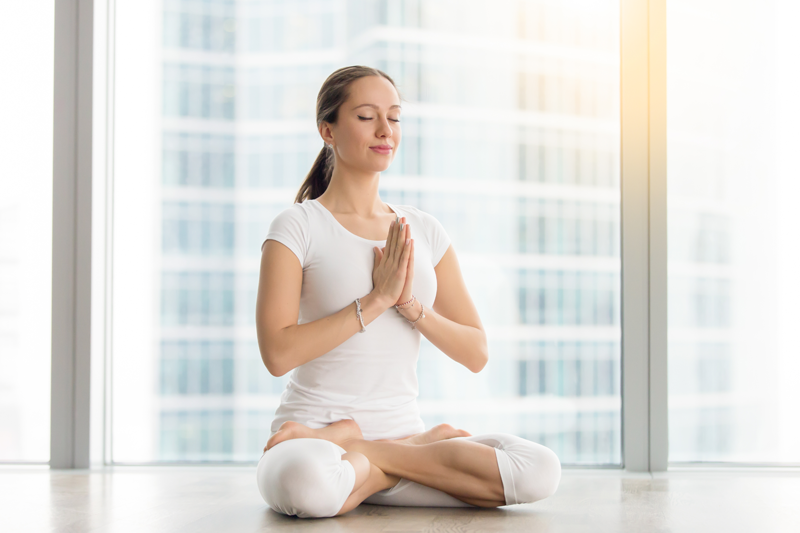
How to Improve Flexibility with Yoga
24th November 2017
Top 9 Yoga Blogs
5th December 2017Restorative Yoga

Today, more people than ever are benefitting from regular yoga practice. With the alternative therapy exploding in the West, a range of new styles have been built based on the traditional forms. Expressing their own blend of postures and breathing techniques, each style boasts different health benefits. Restorative yoga focusses on healing, relaxation, and recuperation. Typically involving just five or six poses, a restorative sequence encourages the body and mind to completely relax. Many of the postures are supported by props; not only does this make the postures more comfortable, but it also minimises the amount of energy used by the body. In this article, we explore restorative yoga in more detail. Before beginning, it’s worth picking up a comfortable mat. For a good-quality option, we recommend the Ana Heart Empowering Yoga Mat.
History and Origins
The restorative style is based on the teachings of B.K.S. Iyengar, who encouraged his students to use props to perfect their poses. Regarded as one of the greatest yoga masters in the world, the teachings of Iyengar are now known as Iyengar Yoga. Years later, Judith Lasater, a former student of Iyengar, spread the teachings of her instructor around the world. Before long, the restorative style was popular worldwide.
Effects and Benefits
Relaxes The Body and Mind
Restorative yoga encourages the body to disconnect from the stresses of modern life. The relaxing nature of the style helps prepare the mind for meditation, moving the body into a deeper state of relaxation. Taking time to move through the postures slowly allows the mind to focus on perfecting each pose.
Soothes The Nervous System
Focussing on slow movement and deep breathing, the restorative style triggers the parasympathetic nervous system. Helping to reduce the effects of the fight-or-flight response, this activation is beneficial to both the physical and mental health. Soothing the nervous system allows individuals to enjoy a state of pure relaxation for the rest of the class.
Increases Self-Awareness
The style is often referred to as ‘mindful yoga’, due to the increased level of self-awareness that can be learnt through the practice. The slow nature encourages students to focus on their form and breathing techniques, allowing them to gain maximum benefit from each posture. Additionally, the style increases awareness of physical sensations; this allows students to notice and feel more of the world around them.
Develops Self-Love and Acceptance
In addition to increasing awareness of the outside world, restorative yoga can develop a deeper under-standing of your own body. Not only will this allow you to feel more in tune with your body, it will also help you to connect with your inner-self. Through ongoing restorative practice, students can develop a sense of self-love and acceptance.
Decreases Anxiety
With the endless stresses of modern life, more people than ever are suffering from anxiety. Regular practice of restorative yoga can provide you with a safe place that allows you to reconnect with your inner-self. This connection reminds you of your strength, giving you the confidence needed to tackle the week ahead. Additionally, the deep relaxation restores the memory; this will remind you that you are loved, nurtured, and appreciated.

Poses for Beginners
Child’s Pose
To start, kneel carefully on the ground, sitting back on your heels. Gently bring your forehead down to-wards the floor, until it is comfortably resting in front of your knees. Relax both arms to the sides of your body, and feel the stretch along the entirety of your back. You are in Childs Pose. Hold for 30 seconds while taking deep breaths to increase the stretch.
Supported Heart Opener
Before beginning this pose, make sure to have a comfortable blanket or towel to hand. Once you’re ready, fold the towel or blanket to create a support along the length of your spine. Next, lay down flat with your torso resting on the support. Keep your legs extended as you move your feet hip-width apart. If it feels comfortable, allow your arms to fall to your sides with your palms facing up; alternatively, rest one hand on your heart and the other on your stomach. You are now in Supported Heart Opener Pose. Feel your chest open as you allow your body and mind to relax. Hold the pose for at least 5 minutes, making sure to breathe deeply throughout.
Dead Body Pose
To begin, lie down flat on your back with your heels together, before letting your feet fall sideways. Keep both arms relaxed, letting them fall gently to your sides keeping palms facing upwards. Pull your shoulders down towards your toes, and then slowly back until they are flat on the floor. You are now in the Dead Body Pose. Focus on your breathing, encouraging the release of tension throughout the body.
Supported Side-Lying Savasana
In this posture, you’ll need a couple of towels or blankets to use as a support. Alternatively, you can use pillows instead – if you find this more comfortable. To start, lay on your side with a blanket, towel, or pillow underneath your head. Next, place your other support lengthways in front of your torso. Bending your top leg, gently place your knee on top of the support. You are in Supported Side-Lying Savasana. Allow your eyes to close and take a few minutes to relax, remembering to breathe deeply.
In Summary
Restorative yoga is ideal for those in need of some true rest and recuperation. Whether you’re in search of a safe haven to retreat to after a long day at work, or you’re a working parent hoping to slow down the busyness of family life, practice restorative yoga regularly to reap the benefits. For maximum benefit, make sure to purchase some good quality yoga gear. For a breathable sports bra, we recommend the Ana Heart Ivy Mesh Bra.

